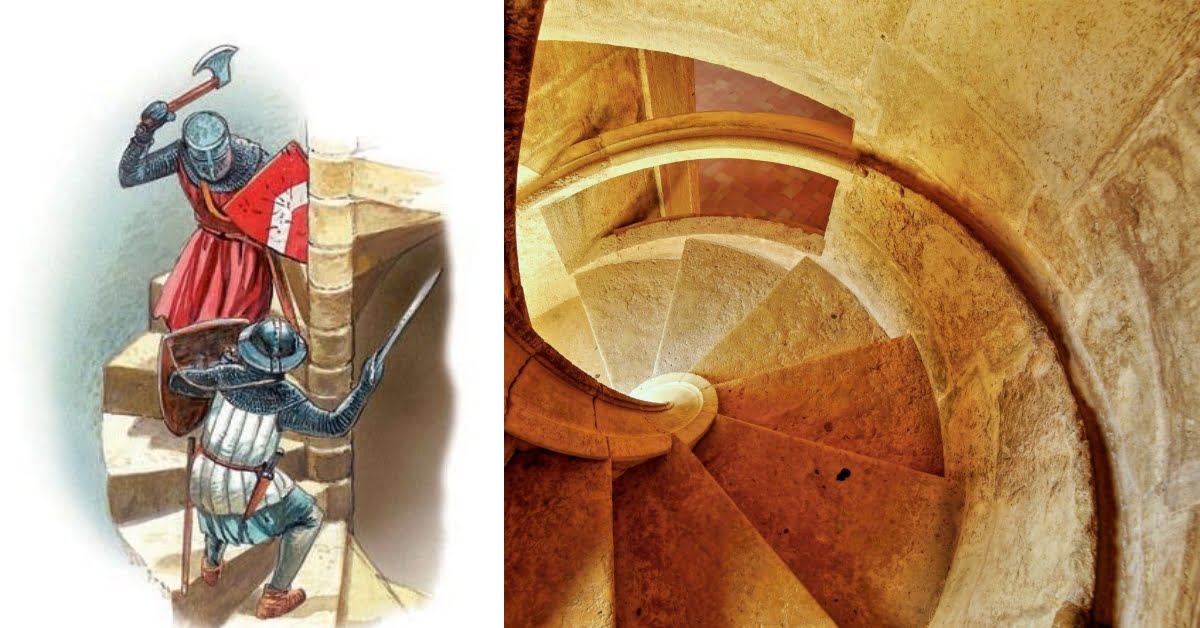According to popular belief, the orientation of spiral staircases in medieval castles was chosen to give the castle's inhabitants an advantage in defense. We checked how valid this claim is.
This is how the essence of this concept is described in one of the publications on the topic of medieval castles in the magazine "World of Fantasy": “In all castles, the stairs twist clockwise. There is only one castle with a reverse twist - the fortress of the Counts Wallenstein. When studying the history of this family, it was discovered that most of the men in it were left-handed. Thanks to this, historians realized that such a design of stairs greatly facilitates the work of the defenders. The most powerful blow with a sword can be delivered towards your left shoulder, and a shield in your left hand best covers your body from this direction. Only the defender has all these advantages. The attacker can only strike to the right side, but his striking hand will be pressed against the wall. If he puts his shield forward, he will almost lose the ability to use weapons.”
This fairly logical argument is also given by Candidate of Historical Sciences Vasily Bulankov in publications "Arguments and facts." They write about it on a number of construction sites. sites, and in fiction, and in collections of facts, and in the authoritative American online magazine Mental Floss. Guides like to talk about the ideas of medieval architects and TV journalists.
To begin with, we note that spiral staircases are not at all a product of the Middle Ages, as it might seem when reading educational articles. Even in the Old Testament, when describing the temple of Solomon are mentioned “round stairs” along which people climbed to the middle tier. Remains of a spiral staircase discovered and among the ruins of another sanctuary - in Sicilian Selinunte. One of the oldest surviving spiral staircases allows climb Trajan's Column from the inside (113 AD). In general, the ideas of Roman architects are considered the prototype of spiral staircases in medieval castles, so popular in historical cinema.
However, upon closer examination of the issue, several problems arise at once.
Firstly, and this is important, not a single source has reached us that speaks of such calculations by medieval architects: no documents, ordinary manuscripts, or even graffiti. In other words, this statement, by definition, can be nothing more than a hypothesis, a guess based on bare statistics.
Secondly, contrary to the stories of guides, stairs in medieval castles do not always go up clockwise. For example, about ten years ago, specialists from the British Castle Research Group published study, which revealed that there are at least 85 castles in England and Wales with staircases oriented in the opposite direction. The time of construction of these castles is 1070–1500, that is, a period when the capture of a castle was commonplace, and architects planned their creations very rationally. Another one brought similar results study, from which, together with the previous one, it follows that the share of such locks is quite sensitive 30%. Moreover, judging by the dates of the appearance of the structures, the further away, the more noticeable this share was. This also raises serious doubts about the veracity of the urban legend. After all, a counterclockwise oriented staircase not only neutralizes the advantage of the average castle defender - it, according to the same logic, makes his position a losing one. In addition, sword fighting on stairs generally means that the legs of the defenders are not protected from the swords of the attackers. Attackers can attack the open legs of defenders with their shield raised. Therefore, the very idea of such battles and any serious hope for them does not seem very well thought out.

An additional problem is that most medieval staircases are extremely steep and narrow. The steps of such stairs have such a small area that standing on them and swinging a sword (in any direction) is extremely inconvenient. Not to mention that the sword will hit the walls. If the heavy sword nevertheless falls down towards the attacker, then in some cases, by inertia, it will pull the defender along with it. A lighter sword, in turn, requires a sharp forward throw, which entails the same problem.
And finally, if the enemy has already penetrated inside the castle, then this is equivalent to the fact that the castle has been taken. The basis for the reliability of a castle is its walls (or even a fortress wall around the building), a deep moat, but not a one-on-one battle with an enemy who obviously has supplies from outside. Moreover, studies conducted in the 1970s–1990s showedthat medieval castles were primarily decorative structures that emphasized the status of their owner, luxurious residences, and only then fortifications.
It is interesting that the so-called swordsman theory, as the concept we are considering is often called, interested researchers back in the 19th century. Even then, the military engineer and architect Eugene Viollet-le-Duc in his extensive work came to the conclusion that spiral staircases in castles were “only a means of reaching the upper floors of the home.” Nevertheless, this legend not only did not disappear, but also continues to exist, in which modern researchers They see the “guilt” of the British art critic, writer and great fan of fencing, Theodore Andrea Cook, who at the beginning of the 20th century described in detail all the now popular details of the legend in his works.
Most likely not true
Read on the topic:
- Mediaeval Mythbusting Blog #3: The Man Who Invented the Spiral Staircase Myth
- No, Medieval Staircases Weren’t Designed to Give Right-Handed Defenders an Advantage
If you find a spelling or grammatical error, please let us know by highlighting the error text and clicking Ctrl+Enter.







